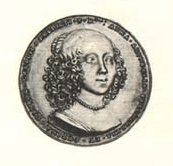Anne Arundell
| Baroness Baltimore Anne Arundell Calvert | |
|---|---|
|
| |
| Personal details | |
| Born |
c. 1615/1616 Arundel Castle, Arundel, West Sussex, England |
| Died |
23 July 1649 (aged 34-33) Middlesex, England (now Middlesex, United Kingdom) |
| Spouse(s) | Cecilius Calvert, 2nd Baron Baltimore, (1605-1675) |
| Relations | Benedict Calvert, 4th Baron Baltimore, (1679-1715; grandson) |
| Children | Charles Calvert, 3rd Baron Baltimore, (1637-1715) |
| Religion | Roman Catholic |

Anne Calvert, Baroness Baltimore (née Arundell; 1615/1616[1] – 23 July 1649[1]) was an English noblewoman, daughter of Thomas Arundell, 1st Baron Arundell of Wardour by second wife Anne Philipson,[2] and wife of Lord Baltimore, who founded the Province of Maryland colony. Anne Arundel County in Maryland, (the third of the state's 23 counties/jurisdictions), in the U.S., was named for her. In addition, USS Anne Arundel (AP-76), an American naval transport ship of the Elizabeth C. Stanton-class was in turn named after the Maryland county. It served in the United States Navy from 1940 to 1970.
Family
She married Cecilius Calvert, second Lord Baltimore, (1605-1675), in 1628 at age 13 when he was 18. This was when his father Sir George Calvert, first Lord Baltimore, (1578-1632), was embarking on his first colonial endeavor in Avalon located in Newfoundland (of future eastern Canada) and six years before son Cecilius after the death of his father, supervised the sailing of the second colonial enterprise in 1633 to the Chesapeake Bay area, north of the earlier colony of Virginia, which was named "Maryland" after Henrietta Maria, the wife and Queen of King Charles I, (1600-1649). A settlement arrangement for the marriage between them was made on 20 March 1627/28.[1][2] According to Gibbs, she is said to have been a most beautiful and accomplished woman.[1] Of her nine children with Lord Baltimore, three survived to adulthood.[3]
- Charles Calvert, 3rd Baron Baltimore[1] (b. 27 August 1637, d. 21 February 1715)
- Hon. Cecil Calvert.[3]
- Hon. George Calvert (b. 15 September 1634 – d. Jun 1636)[1]
- Hon. Georgiana Calvert[3] (b. August 1629)
- Hon. Mary Calvert[4] (born 18 July 1630)
- Hon. Anne Calvert[3] (born 9 October 1636 – died 6 May 1661)
- Hon. Mary Calvert[3] (b. 30 November 1638 – on or before 24 September 1671)
- Hon. Elizabeth Calvert[3] (born circa 1642 – died 16 January 1712)
- Hon. Frances Calvert.[3]
Lady Anne Arundell, was buried at the St. John's Parish church in Tisbury, Wiltshire in England.[1]
References
- 1 2 3 4 5 6 7 G.E. Cokayne; with Vicary Gibbs, H.A. Doubleday, Geoffrey H. White, Duncan Warrand and Lord Howard de Walden, editors, The Complete Peerage of England, Scotland, Ireland, Great Britain and the United Kingdom, Extant, Extinct or Dormant, new ed., 13 volumes in 14 (1910-1959; reprint in 6 volumes, Gloucester, U.K.: Alan Sutton Publishing, 2000), volume I, page 394. retrieved from Lundy, Darryl. "pp. 2614 § 26138". The Peerage.
- 1 2 L. G. Pine, The New Extinct Peerage 1884-1971: Containing Extinct, Abeyant, Dormant and Suspended Peerages With Genealogies and Arms (London, UK: Heraldry Today, 1972), page 9; retrieved from Lundy, Darryl. "p. 2614 § 26138". The Peerage.
- 1 2 3 4 5 6 7 Douglas Richardson, Kimball G. Everingham. Magna Carta ancestry: a study in colonial and medieval families. Genealogical Publishing Com, 2005, p. 169.
- ↑ George Edward Cokayne, editor, The Complete Baronetage, 5 volumes (no date (c. 1900); reprint, Gloucester, U.K.: Alan Sutton Publishing, 1983), volume II, p. 188.
External links
- Calvert Family Tree; retrieved 10 July 2013